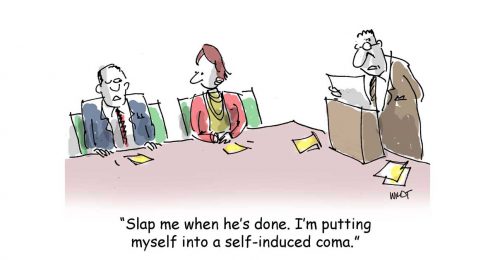There’s a word I hear from nonprofit leaders more than any other.
Can you guess what it is?
It’s not inspired, lucky, or meaningful. I wish!
It’s also not frustrated or burned out. Thank goodness!
Here it is… the word I hear more than any other from nonprofit leaders….
Overwhelmed.
Ok, that’s probably not a big surprise. Leading a nonprofit can feel completely overwhelming. And the biggest reason is that it can be hard for nonprofit leaders to wrap their heads around all the things they need to attend to.
One of the more popular posts I’ve written was called “The 14 Attributes of a Thriving Nonprofit”.
Sure it was popular, but what was I thinking? Fourteen attributes? Really?
Fourteen feels like an awful lot of things to worry about. I’m not sure I helped anybody feel any less overwhelmed.
But here’s the truth. If you look a little bit closer you’ll see that in reality there are only five things… five pillars… that a healthy and thriving nonprofit handles really well.
Just five.
Get these five things right and your nonprofit will soar.
So are you ready to lighten your load? Feel some weight come off your shoulders?
Let’s dive into the five pillars of a thriving nonprofit.
PILLAR 1: PEOPLE
Hey Joan – that is no bite sized pillar – who are you kidding? Hang on – be patient. I’ll get you there.
The “People” pillar is all about whom you have and how they work together.
Regardless of the number of full time staff, every nonprofit has a group of people who do the work. Board members, volunteers, and if you are lucky, a bunch of paid staff.
Your people are your #1 priority. Only very good people can do very good work. And of course only great people do great work.
Your job is to constantly assess the caliber of your people and to be ready to take action.
When do you take action? When you start sentences with the phrase, “I wish.”
“I wish my program director was stronger,” or “I love being board chair but I just wish my treasurer would actually show up for the budget meetings.”
When it comes to the makeup of your team, here are two pieces of advice:
1. Look a donor in the eye.
Imagine that I am your biggest donor and pretend that I have underwritten the annual salary of one of your full time staff people. She happens to be a poor performer. Look me in the eye and tell me that my investment is being used to its fullest advantage.
If you blink, it’s time to take some kind of action.
2. Who’s on the bus?
Take everyone involved with your organization – staff and board – and put them on an imaginary bus. If it helps, think of them all as 3rd graders en route to some kind of day trip.
Divide the kids into three groups:
- The best of the bunch – you would burst into tears if one of them resigned from your board or was offered another job.
- The worst of the lot – if these folks said, “I’d like to get off at the next stop,” you would cheer.
- Everyone else. What I mean here is that you are just simply not sure. Maybe they are new or maybe just inconsistent. Jury still out.
OK, now what? You can’t focus on everyone. You can’t do everything (after all there are 4 other pillars J). So whom should you focus on?
My advice may feel counterintuitive. You might think that I’ll suggest that you work on getting poor performers off the bus.
But I think your best use of time is to figure out the “everyone else” category. Invest time there and see if you can build a bigger bunch of the best. And while you are doing that, start tossing juice boxes and cheese doodles to the folks you want to retain. And make sure everyone sees you doing it.
As for how your people work together? I promised not to overwhelm you today so I’ll leave that question to other posts (like this one or this one.)
PILLAR 2: PROGRAMS
The two things you must concern yourself with when it comes to your programs are these:
- Are they mission-centric?
- Do they show clear and measurable impact?
Do you all remember the tune from Sesame Street – “One of these things is not like the other!”
I’m working with an organization that works with homeless young men – most under the age of 21. The organization offers an array of services that support these men along a journey to get back on their feet.
I asked the Executive Director to describe how each program supports that journey. She enthusiastically explained the trajectory and when she was done I asked, “So where does the low income housing fit in – do the men live there when they get jobs?”
No, I’m told. That’s just another program we have.
Um… we have a problem here.
I hear stories like the above all the time. The reasons aren’t always the same but I can’t tell you how many folks develop new programs to follow money or keep existing programs around even if they are not mission-centric.
So I asked a follow up question.
“If you eliminated that program, wouldn’t you be able to invest those dollars and improve the quality of the trajectory of service for those young men?”
Besides crickets I didn’t hear much else.
Keeping your programs on-mission requires discipline and sometimes difficult decisions.
PILLAR 3: MONEY
I’m talking money in and money out. Fundraising and financial stewardship.
You can’t spend beyond your means. You need to put money away for a new toy or unforeseen crisis. And the money needs to come from diverse sources.
For some reason, this seems hard for nonprofits. But even worse, so many people can be heard around boardroom tables saying, “I just don’t get numbers.”
OK kids, so try this.
Pretend your favorite 17-year-old niece comes to stay with you for the summer and your job is to teach her about money. Let’s say her parents send her with $1,000 so that you don’t have any out of pocket expenses. How would you approach the lesson?
Make any choices you want – this scenario is imaginary. You can play the stock market. She can get a job. She can volunteer. Whatever you think.
What would you teach her so that at the end of the summer she understood the value of money and was in a stronger financial position (maybe that means more money and maybe it doesn’t).
Most grownups would be up to that task. Percolate on that idea before your next board meeting and I guarantee that you will start asking good questions when it’s time to look at year to date financials or the proposed budget.
PILLAR 4: STRATEGY
This isn’t vision or a strategic plan.
I picked this word with intention. Your organization needs to make its decisions strategically. You need to be able to articulate the why behind every decision of substance.
And as for the destination, one of my clients likes to use the phrase, “But not for XYZ.org…..” This is a good one for a big strategy conversation. In three years time, because of XYZ.org, ABC will happen.
One quick bite sized piece of advice: At the start of your next strategy conversation, pose this one question to the group:
“If our organization were erased from society’s hard drive, what gap would there be and who would fill it?”
No question gets your attention faster and no question forces you to develop a strategy with a clear and distinct destination.
PILLAR 5: NARRATIVE
This is not last because it is least important. It’s last because it’s the story you tell about the other four.
Each and every person must be able to talk about your organization in a way that is compelling, clear and concise.
This can be very hard for organizational ambassadors, board and staff. Not because they aren’t clear about what the organization does but rather because they “gush.” They just start talking and talking because they love the work and the staff and the clients. And they don’t know when or how to zip up the old pie hole.
Here’s the bite sized piece of advice here. Go find a 10-year-old kid. If you have one in your own home, great. Otherwise, I’m sure you have one in your neighborhood, your family, your building.
Tell the kid about your organization. See if he gets it. See what questions he asks you. Based on those questions, fine-tune the schpiel.
Here’s the most important part of the assignment. Tell the story in such a way that the kid not only remembers the story. He wants to tell a friend.
If you can do that, you get a juice box and bag of cheese doodles.
THOSE 5 THINGS SEEM LIKE AN AWFUL LOT…
It’s true. I admit it.
There’s a lot to unpack within these 5 pillars. My hope is that by helping you to see the big picture with a little more clarity it will help you keep the main thing the main thing, as Stephen Covey once wrote in The 7 Habits of Highly Effective People.




Your “5 Pillars of a Thriving Nonprofit” is the model I always begin with whenever initiating engagement with a new partner. AND… I’ll be proposing that the entire Nevada Circuit Rider Roster of Consultants — with whom I am now affiliated through the Nevada Arts Council — consider doing the same!
The Nevada Circuit Rider program offers local arts agencies, municipal entities and other nonprofit organizations up to $4,000 to pay consultants to address specific issues and/or challenges, such as Cultural Planning, Board Development, Program Development and Strategic Planning. As a Nevada Circuit Rider consultant, I am now a recommended consultant for organizations to select when applying for a Nevada Circuit Rider grant.
Enjoy the rest of your summer!